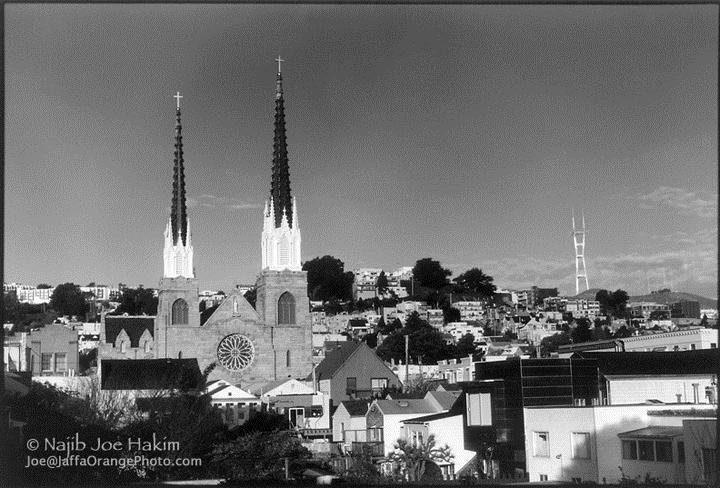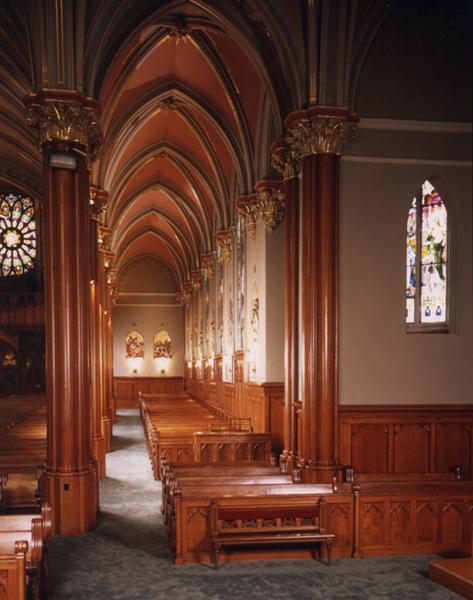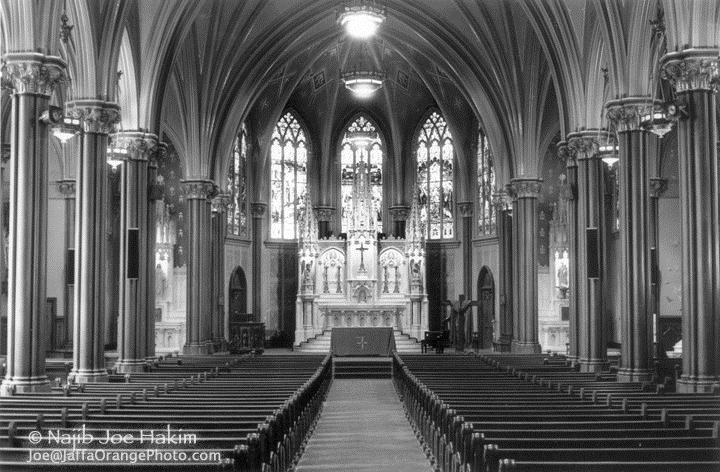
RETURN TO HOME PAGE
FEEDBACK
 |
May 2011 RETURN TO HOME PAGE FEEDBACK |
By Corrie M. Anders

The spires of St. Paul’s, which were restored in 2009, can be seen from many vantage points in San Francisco. Photo by Najib Joe Hakim St. Paul’s Catholic Church—which has survived earthquakes, the filming of a Hollywood movie, and major renovations, including repair of its soaring twin spires—celebrates its centennial this month.
And that is cause for a big gathering at the Noe Valley landmark at Church and Valley streets. Archbishop George Niederauer, California’s highest-ranking prelate, will offer a mass of Thanksgiving at the stately granite church on May 29.
“He will bless the church exactly 100 years to the day after the original blessing,” said Father Mario Farana, St. Paul’s longtime pastor.
A reception will be held at the Parish Center immediately following the 12:15 p.m. mass. Early church letters, vintage pictures, old vestments, and other church memorabilia will be on display throughout the center and inside the adjacent St. Paul’s Elementary School. The neighborhood is invited to come visit until 4 p.m.
For its entire existence, the church has been “like an anchor in the community,” said Farana, 66, who in 1993 became the ninth pastor to guide the faithful at St. Paul’s.
“This is where celebrations in people’s lives have taken place, both happy ones and sorrowful ones, weddings and baptisms and confirmations,” he said. “It’s a place where people can gather to get support, to have that sense of family and community, to feel and understand that they are not isolated nor alone, and to feel the presence of the Lord Jesus in their lives.”
It was that sense of religious and secular closeness that prompted families in Noe Valley’s then rural hinterland to found St. Paul’s Parish in the 1870s. The original church, whose cornerstone was laid in 1880, quickly outgrew its 750-seat capacity at the parish site at Church and 29th streets.
Work began on the current church in 1897, but was halted when the 1906 earthquake that devastated much of San Francisco caused church fathers to redesign the unfinished structure (see below).
“The ’06 earthquake did some damage, to the extent that they had to stop, go back, and reinforce,” Farana said.

The side aisles at St. Paul’s provide a quiet place for contemplation. Photo by Russell Abraham courtesy Stanton Architecture
Father Michael D. Connolly, who was pastor at the time and a man known for his enterprise, convinced city officials to let St. Paul’s gather granite and curbstone from the quake ruins to augment the new church. Most granite was mined from a quarry at 30th and Church streets.
When the building was finally dedicated on May 29, 1911, 14 years after its inception, the parish owned an architectural jewel described by the May 27 Catholic Monitor as “San Francisco’s Most Beautiful Church.” The edifice, built at a cost of $260,000, had room for 1,400 congregants.
Beyond its stone faŤade, the building, designed in the English-Gothic style by architect Frank T. Shea (with help from Father Connolly), features lofty arched ceilings that allow light to showcase stained-glass windows imported from Germany and an altar made of Carrara marble from Italy. Its two asymmetrical steeples—one rising 170 feet and the other 200 feet—can be admired from many vantage points in San Francisco.
“There’s no reason that I’m aware of, or anyone else is aware of, why one is taller than the other,” said Farana. “Perhaps the architect thought aesthetically it looked better.”
Strong earthquakes rattled the building in 1957 and 1989, though they caused little damage. But the Catholic Archdiocese threatened to shutter the parish after the second tremor, worried that it would be too expensive to bring the church and its school buildings up to code.
However, after a spirited fundraising effort, the church closed in 2000 for a yearlong seismic retrofit of its parish buildings, costing $8.5 million. During the renovation, by Stanton Architecture of San Francisco, more than 50 tons of new steel were used to brace the roof and the attic. In 2009, the heavy slate tiles decorating the two steeples were replaced to further ensure the safety of church-goers and pedestrians.
Numerous dignitaries have called St. Paul’s their spiritual home, including former San Francisco Mayor John Shelley, former Sheriff Matt Carberry, and former city treasurer Mary Callanan.
And then there’s Whoopi Goldberg. In 1991, Disney filmed the movie Sister Act, in which Goldberg starred as an activist nun, in and around St. Paul’s.
The movie has “has brought us publicity,” smiled Farana. During the 1990s, camera-toting tourists included St. Paul’s on their must-see list of places in the city.
On any given Sunday, St. Paul’s has at least 700 worshipers, said Farana. Membership has waxed and waned over the years. The church was at its zenith from the 1930s through the 1960s. But in the ’60s, families with children began moving out of the city and to other Bay Area communities. That period also saw the start of a general decline in church attendance.
“I think the Catholic Church in San Francisco is struggling right now. There are fewer people going to church,” Farana said.
Still, he said, St. Paul’s was built on solid ground, literally and metaphorically, and he is optimistic the church will be around long enough to celebrate a second hundred years.
St. Paul’s, he said, is “a big strong building, solidly here in Noe Valley forever, pointing to the future and living in the present.”
Triumph and Tragedy
This passage from a church history of St. Paul’s was written about 30 years ago by John H. McGuckin:
The parishioners played a major role in constructing their Church: the men, women, and children had a wonderful spirit and they eagerly donated their time and talents. It was common to see the pupils from the Saturday morning catechism classes hauling rocks down from the 30th and Castro streets quarry, or in front of the building, chipping rocks.
1902 marked a tragic incident for St. Paul’s Parish. A young man named Thomas Dolphin was a carpenter’s apprentice working on the Church steeple. According to legend, it was just about quitting time as Mr. Dolphin was about to place the cross on the steeple when he slipped, fell, and died. He was 20 years old, married, and had two children. A concrete cross is imbedded in the sidewalk at the corner of Church and Valley to commemorate the death of this young man.
April 18, 1906, marked a tragedy for San Francisco—the Great Earthquake and fire. Although the walls of St. Paul edifice were standing in 1906, the structure was undamaged by the earthquake. Father Connolly insisted that his Church be built like a fortress. He therefore had all construction heavily reinforced. He also changed the size of the second tower, which was to be larger than the first, but, with further earthquakes in mind, Father Connolly made it smaller than originally planned.

One of St.Paul’s most striking features is its altar, made of marble shipped from Carrara, Italy. Photo by Najib Joe Hakim